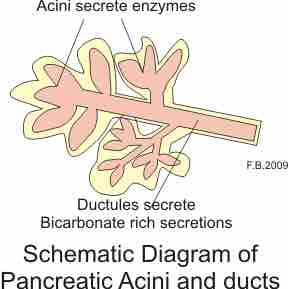The pancreas is a glandular organ in the digestive system and endocrine system of vertebrates. It is both an endocrine gland producing several important hormones including insulin, glucagon, somatostatin, and pancreatic polypeptide, and a digestive organ, secreting pancreatic juice containing digestive enzymes that assist the absorption of nutrients and the digestion in the small intestine. These enzymes help to further break down the carbohydrates, proteins, and lipids in the chyme.
Pancreatic fluid or juice contains digestive enzymes that pass to the small intestine where they help to further break down the carbohydrates, proteins, and lipids (fats) in the chyme. Pancreatic juice is a liquid secreted by the pancreas, which contains a variety of enzymes including trypsinogen, chymotrypsinogen, elastase, carboxypeptidase, pancreatic lipase, nucleases, and amylase.
Pancreatic juice is alkaline in nature due to the high concentration of bicarbonate ions. This is useful in neutralizing the acidic gastric acid, allowing for effective enzymic action.
Pancreatic juice secretion is regulated by the hormones secretin and cholecystokinin. It is produced by the walls of the duodenum upon detection of acid food, proteins, fats, and vitamins. Pancreatic secretion consists of an aqueous bicarbonate component from the duct cells and enzymatic component from the acinar cells.
Because the pancreas is a sort of storage depot for digestive enzymes, injury to the pancreas is potentially fatal. A puncture of the pancreas generally requires prompt and experienced medical intervention. A variety of factors cause a high pressure within pancreatic ducts. Pancreatic duct rupture and pancreatic juice leakage cause pancreatic self-digestion.

Pancreatic Fluid
Schematic diagram showing pancreatic acini and ducts where fluid is created and released.